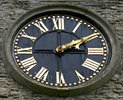Elston All SaintsClock
 The clock was made in 1838 by Whitehurst & Son of Derby. The firm was started by John Whitehurst, a friend of Erasmus Darwin and fellow member of the Lunar Society. Whitehurst & Son was one of the three firms, by then known as John Smith & Son, who in 1846 were asked to tender for a clock for the new Houses of Parliament, referred to now as “Big Ben” which is actually the name of the hour bell. The clock was probably paid for by William Brown Darwin who gave the church an extensive makeover in 1837 and raised the tower to accommodate the clock. The new clock was larger than the old one and a larger face was fitted facing the road of Top Street. The clock was made in 1838 by Whitehurst & Son of Derby. The firm was started by John Whitehurst, a friend of Erasmus Darwin and fellow member of the Lunar Society. Whitehurst & Son was one of the three firms, by then known as John Smith & Son, who in 1846 were asked to tender for a clock for the new Houses of Parliament, referred to now as “Big Ben” which is actually the name of the hour bell. The clock was probably paid for by William Brown Darwin who gave the church an extensive makeover in 1837 and raised the tower to accommodate the clock. The new clock was larger than the old one and a larger face was fitted facing the road of Top Street.
Prior to the new clock, the former clock had a clock face on all four walls of the tower. The three apertures were filled in with a slightly lighter stone which can still be seen when the new clock was fitted.
The clock has a cast iron frame with brass bushes, a pin wheel gravity escapement with maintaining power and is in its original condition, in the sense that it has not been converted to electric winding. This means that the striking weight which weighs approximately 314kg has to be wound up the full height of the spire (47 feet) every week.
When the clock was first built, it was necessary to set the time with a sundial so each village might have its own local time – many country clocks only had an hour hand anyway. With the growth of the railway network and the need for timetables, it was necessary to establish a standard time throughout the country, so starting in 1852 the Greenwich Time signal was telegraphed to each Railway station at 10am each day. Some later instructions for the clock recommend that the attendant obtain the correct time from the Railway station each week, so presumably he would ride into Newark on his horse and set his watch to the correct time then trot back and put the clock right.
|